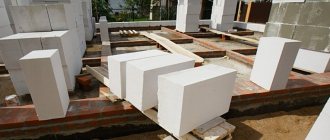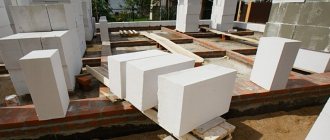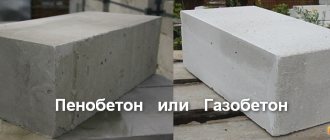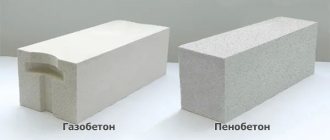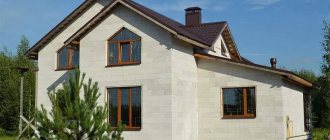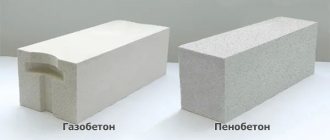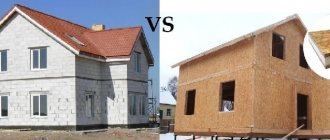Aerated concrete as a building material has been known for more than a century. However, it began to be used for the construction of private houses relatively recently. Interest in this material is constantly growing and the main question is how to choose aerated concrete and which aerated concrete blocks are best used for building a house. Not only the strength of the future building depends on this, but also the speed of its construction and the comfort of living in the future.
Advantages of houses made of aerated concrete with a wall thickness of 300 mm
Houses made of aerated concrete can rightfully be called stone, since this material is an artificial stone made using a certain technology. When making aerated blocks, a mixture of cement and quartz sand is moistened and special gas-forming compounds are introduced. As a result, when concrete hardens, pores are formed, and the structure itself becomes light and durable.
After the mixture has set, it is cut into blocks of a given size and dried under natural conditions or in autoclaves. Aerated concrete buildings have all the advantages of stone houses, and due to the special properties of the material, they are practically devoid of disadvantages. In addition, buildings acquire additional benefits. Thus, a house made of aerated concrete walls 300 mm thick acquires the following qualities:
- strength, which is due to the ability of aerated concrete to withstand fairly high mechanical loads;
- light weight, since gas-filled concrete has a low density compared to brick or heavy concrete;
- low thermal conductivity of the walls, also due to the low density of the material (heat-insulating blocks have even lower thermal conductivity than wood);
- good sound insulation, which is ensured by the large acoustic inertia of the walls and high rigidity of the structures (these qualities do not allow vibrations under the influence of sound waves, which prevents the passage of sound through the walls);
- high speed of construction of buildings is possible because gas blocks have large dimensions, which are very precisely maintained during production, and are easily processed with hand tools;
- The environmental friendliness of the houses is due to the fact that only pure quartz sand and high-quality cement are used in the production of blocks;
- the frost resistance of structures protected from direct precipitation is quite high;
- the low flammability of the material and the high fire resistance of structures made from it are due to the use of non-flammable components in the production of gas blocks;
- low price (1 m² of aerated concrete wall is cheaper than brick)
Expert opinion Vitaly Kudryashov builder, aspiring author
Ask a Question
In houses made of aerated concrete, it is allowed to install both light floors on wooden or steel beams and massive concrete monolithic floors. The strength of block walls is sufficient to withstand heavy weight.
Production of artificial stone
One of the varieties of porous concrete is represented by artificial stone with porous cells. A building material called aerated concrete has become another option for a simplified, cheapest way to build affordable and high-quality housing.
The following materials are used for the manufacture of foam blocks:
- Quartz sand.
- Marked cement M400 or M500.
- Gas-forming pastes based on aluminum powder.
- Lightening additives and additives in the form of ash, slag, gypsum or lime.
- Pure water.
The resulting mixture is subjected to high pressure and heat until a chemical reaction occurs. After foam formation, the blocks harden in the desired shapes and several standardized sizes.
The quality of the concrete produced must comply with GOST standards 23732-79 and 10178-85.
To produce a lightweight cellular material 1 m3 in size, 95 kg of cement, 375 kg of quartz sand, 35 kg of lime or other plastic additives are required. All dry components are mixed with 300 liters of purified technical water.
Types of gas blocks
The marking of aerated concrete blocks includes the capital letter D and a number indicating the density of the material. For example, D500 is a designation for aerated concrete with a density of 500 kg/m³. Depending on the density of the material, there are three types of blocks:
- thermal insulation,
- structural and thermal insulation,
- structural.
The name of each type also indicates the purpose of the blocks; replacing one type with another is not allowed. Using blocks for other purposes not only threatens to deteriorate the characteristics of the building, but can also lead to its destruction.
Thermal insulation
Thermal insulation materials include aerated concrete grades D300-D400. Due to its low density, such material does not transmit heat well. However, a large number of pores reduces the strength of the material.
Non-load-bearing walls are made from thermally insulating aerated concrete blocks, which during operation do not take any load other than their own weight. Such walls are laid during the construction of buildings that have a spatial frame of reinforced concrete panels or columns. The blocks simply fill the areas of the external walls, leaving openings for windows and doors in them.
The walls of each floor rest on the floors; the maximum height of such a wall is no more than the height of the floor. Therefore, the blocks are not subject to heavy loads.
Structural and thermal insulation
This type of aerated concrete, which includes products of the D500-D900 brands, is used as a universal one. The blocks carry a large load, but their thermal conductivity is low. Such blocks can be used to lay out load-bearing walls of two- or three-story houses, even if the floors are reinforced concrete, and internal partitions. In temperate climates, the walls don’t even need to be insulated. Blocks of this type are most often used in the construction of private houses.
Structural
The density of structural concrete is equal to or exceeds 1000 kg/m³. This type includes blocks of grade D1000 and higher. Such materials are used for the construction of load-bearing walls of multi-story buildings. Due to the high density of the material, the external elements of buildings built in cold climates require mandatory insulation.
Aerated concrete is used not only for the production of wall blocks. Reinforced lintels, beams and slabs for prefabricated floors are also made from this material. But you cannot build a foundation from aerated concrete. Even with high density, this material is capable of absorbing large amounts of moisture, which destroys it over time. For the same reason, it is necessary to carry out horizontal waterproofing between the foundation and the walls made of aerated concrete.
Differences in manufacturing technology
Aerated concrete is produced using two technologies:
- autoclave;
- non-autoclave (natural hardening).
The difference between them lies in the completion of the technological process - autoclaved material is kept in an atmosphere of superheated steam under pressure, and non-autoclaved material is kept only in a hot steam bath without pressure.
Initially, non-autoclaved aerated concrete was developed. It is characterized by an incomplete ripening cycle - after exposure to an atmosphere of superheated steam, the material does not fully gain structural strength and continues to ripen during operation. this property was considered a disadvantage, since it was impossible to apply current standards to material with changing indicators.
Autoclaved aerated concrete has a fully completed maturation cycle. This has made it a sought-after and recognized material suitable for residential construction. Aging in an autoclave under pressure makes it possible to obtain durable and stable aerated concrete that retains its qualities throughout its entire service life (taking into account the inevitable aging processes). The production of non-autoclaved aerated concrete was curtailed and remained only in small firms that were not equipped with the necessary equipment,
However, studies of old houses in Europe that have served for 80 years or more, carried out as part of testing the suitability of housing for use, showed an amazing picture - the quality of aerated concrete turned out to be much higher than that of modern autoclaved material. It turned out that over the past years the maturation process did not stop and gradually continued. The strength and hardness of the material gradually increased, making these houses almost stronger than in the year they were built. These studies revived the production of non-autoclaved aerated concrete, and attitudes towards it changed in the opposite direction. Today, both types of material are in equal demand and are considered quite suitable for building individual housing.
Which brand of aerated concrete to choose
When designing buildings, the choice of brand of aerated concrete blocks is made taking into account the properties and characteristics of the material. Replacing thermal insulation blocks with structural ones without changing the insulation will significantly increase the overall thermal conductivity of the structures and the building will be cold in winter and hot in summer. If, instead of structural blocks, thermal insulation is used, the load-bearing structures may simply not withstand the load and collapse.
Replacing some blocks with others of the same type, but of a different brand, is also not recommended. If such a need arises (due to the lack of the required brand from the supplier), replacement should be made only after a clarifying calculation of the structures for strength and thermal conductivity.
Expert opinion Vitaly Kudryashov builder, aspiring author
Ask a Question
The higher the grade of aerated concrete, the higher the price of 1 m³ of material. For large volumes, the use of a brand with excessive strength often leads to a significant increase in the cost of the structure. In addition, for blocks with a higher density, more effective insulation is required; choosing a brand “with a margin” is not always justified.
To decide which brand of gas block to choose for building a house, you need to take into account many factors. To simplify this task, recommendations for choosing aerated concrete are given in the table.
| Structures and elements of buildings | Brand of aerated concrete | ||||||||||
| D300 | D400 | D500 | D600 | D700 | D800 | D900 | D1000 | D1100 | D1200 | ||
| Load-bearing walls of low-rise buildings without insulation | Building with wooden beams | — | — | + | + | — | — | — | — | — | — |
| Building with concrete floors | — | — | + | — | — | — | — | — | — | — | |
| Insulated load-bearing walls of low-rise buildings | Building with wooden beams | — | — | + | + | + | — | — | — | — | — |
| Building with concrete floors | — | — | + | + | + | + | — | — | — | — | |
| Load-bearing walls of multi-storey buildings | Building with wooden beams | — | — | — | — | — | — | — | + | + | + |
| Building with concrete floors | — | — | — | — | — | — | — | — | + | + | |
| Walls of one-story houses with wooden floors | + | + | + | — | — | — | — | — | — | — | |
| Walls of frame buildings | + | + | — | — | — | — | — | — | — | — | |
| Partitions | + | + | + | — | — | — | — | — | — | — | |
| Beams, reinforced lintels | — | — | — | + | + | + | + | + | + | + | |
| Reinforced floor elements | — | — | — | — | — | + | + | + | + | + | |
Rating of companies in Russia
The rating is determined based on the results of purchases of aerated concrete ; as a rule, it is conducted by large trading platforms covering all regions of Russia. The rating takes into account such key indicators as: brand of aerated concrete, price, characteristics and logistics of cargo with delivery and unloading at the construction site.
In accordance with the brand and standard sizes, aerated concrete has distinctive characteristics in terms of density, fire resistance and thermal conductivity. The density of the block is directly related to its strength. The more cement a product contains, the more durable it is, and, consequently, the colder, since concrete conducts thermal energy well. Aerated concrete is marked by density, for example, for D500 it is 500 kg/m3.
Important ! Aerated concrete building material must have a high fire resistance class and withstand high combustion temperatures for more than 1 hour. An equally important indicator is the price of aerated blocks and delivery logistics, which will significantly affect the cost of the house.
A comparison of block characteristics is shown in the table.
| № | Manufacturer aerated concrete blocks | A country | Model | Price per 1 m3 | Advantages | Flaws |
| 1 | AEROC | Russia, 2004 | D500/400/300 625x200x250 625x375x250 625x400x250 | 4750 |
| Not detected |
| 2 | YTONG® | Russia, 2007 | 625x250x200 625x250x75 625 x 250 x 375 | 3900 |
| Low moisture resistance |
| 3 | LSR | Russia, 2010 | D300 (B2.0) D400 (B2.5) D500 D600 (B5.0) U-blocks | 4650 |
| Small assortment |
| 4 | EURO-AIR CONCRETE | Russia, 2008 | D500/400/300 625x200x250 625x375x250 625x400x250 | 3300 |
| Loose porous structure |
| 5 | Lipetsk Silicate Plant | Russia, 2015 | D500/400/300 V1.5-V3.5 | 3100 |
| There are blocks with quality deviations |
| 6 | Main-Sibirskstroy (SIBIT) | Russia, 2007 | B2-D600-B2.5 625/200/250 625/240/250 625/400/250 | 4900 |
| High hygroscopicity |
| 7 | Saratov building materials plant | Russia, 2010 | D500/400/300 625x200x250 625x375x250 625x400x250 | 3200 |
| Lots of fighting when transporting blocks |
| 8 | Kostroma silicate plant | Russia, 1930 | D500/400/300 600x300x200 600x300x100 600x250x400 600x250x300 | 3900 |
| High percentage of deviation in dimensions up to 2% |
Load-bearing capacity of aerated blocks
The load-bearing capacity of aerated concrete is understood as its ability to withstand loads without destruction. This characteristic depends on the strength of the material. And strength depends on density.
Aerated concrete only bears compressive loads. When stretched, it breaks easily. Therefore, this material is used in compressed structures. To determine compressive strength, the concept of concrete class is used. This designation includes the capital Latin letter B followed by a number indicating the size of the maximum compressive load in MPa that the material can withstand. For example, if class B2.5-B3.0 is provided for aerated concrete brand D600, then the material is guaranteed to withstand compression of 2.5-3.0 MPa, and in more conventional units of measurement the value will be approximately 25-30 kg/cm². This is the load-bearing capacity of aerated concrete.
What is the density of aerated concrete
The density of aerated concrete affects not only its strength, but also its thermal insulation properties. The larger it is, the better the concrete conducts heat, and vice versa. Low-density blocks contain more air trapped in closed pores created by gassing. And air, as you know, is the best heat insulator.
The pores in the gas block have almost the same size, in contrast to the foam block, in which pore formation occurs from foaming with air. The density of aerated concrete is the same throughout its entire thickness, and the thermal parameters of the future structure can be calculated more accurately.
Video description
AERED CONCRETE: how are aerated concrete blocks produced using German technology?
UDK
The company uses high-tech equipment from Masa AG. It allows us to produce the best quality aerated concrete blocks that meet high standards. They are distinguished by ideal geometry and a reasonable price.
The government of the UDK company creates educational institutions where they train future specialists for their enterprises. This approach demonstrates a serious attitude to work and far-sighted plans.
The UDK company positions itself as a manufacturer of premium products Source vyborok.com
Hebel
During production, each gas block goes through several stages, including drying. During the latter, shrinkage occurs, changing the dimensions of the elements. The German company Hebel has successfully solved this problem. Their blocks have an almost ideal shape: the maximum deviation from the specified parameters does not exceed 2 mm. For comparison, in products from other manufacturers the error may be several centimeters.
The Hebel company produces a huge range of products. It includes gas blocks for partitions, ceilings, and external walls. The company also produces complex arched structures. It is worth noting the presence of constant quality control of products in production workshops.
Calculation of aerated concrete for crushing
The calculation of blocks for crushing is carried out if the material is exposed to a large load applied to a small area. Such conditions arise, for example, when constructing floors, especially if they are made along beams. In this case, the small supporting platform of the beam bears the load collected along its entire length.
In places of support, collapse of aerated concrete can occur, that is, irreversible destruction within the material. The resulting stresses can simply crush the blocks; they will chip under the influence of the load. To prevent this phenomenon, a calculation is necessary. For it, it is enough to determine the magnitude of the stresses arising from the applied load and compare it with the calculated resistance of aerated concrete.
The stresses are equal to the ratio of the load value to the area of support. For example, if a weight of 2 tons is applied to a wooden beam, then one end of it will press on the aerated concrete masonry with a force of 1 ton (1000 kg). With a beam thickness of 100 mm (10 cm) and a support value of 250 mm (25 cm) on blocks of aerated concrete class B1.5, the area of the support platform will be equal to 250 sq. cm.
By dividing the load by the area of the support area, you can get a stress value of 1000 kg/250 cm² = 4 kg/cm².
Comparing the magnitude of the stresses with the calculated resistance, which for simplicity can be taken knowing the class of aerated concrete - 1.5 MPa or 15 kg/cm², you can see that the strength of the material will be sufficient to support the floor beam. However, this example is provided only to show the calculation mechanism and does not take into account the entire load on the wall. In real conditions, aerated concrete is also pressed by the mass of aerated concrete on the walls of the upper floor, the roof and the weight of the snow load. Therefore, the pressure on the support platform may exceed the permissible value. With a value of 5 tons, the stresses arising in aerated concrete will be equal to 20 kg/cm². And this will already exceed the value of the calculated resistance due to concrete class B1.5.
So what, should we abandon the use of concrete of this class? Not at all, there is a solution to the problem.
What load can an aerated concrete block withstand?
As is clear from the formula for calculating stress, they can be reduced either by reducing the load or by increasing the support area. It is unlikely that it will be possible to reduce the load, since it is determined by the purpose and operating conditions of the building. But it is possible to increase the support area. To do this, just place a wide board at the end of the beam. With a board width of 200 mm (20 cm), the support area will double. The voltage also decreases exactly twice.
Of course, in construction other methods are used to solve this problem. When supporting wooden, steel beams or ribbed floor slabs, a reinforced concrete belt is installed along the top row of aerated concrete blocks. And then beams or slabs are laid on it. Reinforced concrete distributes force over a larger area, reducing stress many times over. As a result of this distribution, one linear meter of a B1.5 aerated concrete wall with a thickness of 300 mm (30 cm) can withstand a load of more than 40 tons!
It is not difficult to check by multiplying the calculated resistance by the support area of 15 kg/cm². * (100 cm * 30 cm) = 45,000 kg.
This is more than enough for a private home. If a monolithic reinforced concrete structure is considered as a floor, then with proper reinforcement there is no need to make a force-distributing belt. The edge of the monolithic slab will evenly distribute them across the thickness of the block.
Tips for masonry work
If the block has already been purchased and the foundation is ready, you should begin laying the products. And so that you can avoid common mistakes, let's look at some practical tips that will be useful for any developer to know.
- Before installation, it is necessary to waterproof the foundation;
- Work should begin from the corners, the first block is laid at the highest point. As a guide, stretch the thread between the products laid in the corners;
- Manufacturers recommend using a specialized adhesive composition. The layer should be as thin as possible in order to reduce cold bridges;
- Laying each subsequent row should be done with a seam offset of approximately 25-30%;
- Reinforcement must be done, this will increase the strength of the structure;
- It is necessary to control the evenness of the installation using a level and a mallet, and as often as possible. Once aerated concrete blocks have been laid, dismantling and preserving the products will no longer be possible;
- A large amount of the mixture should not be mixed immediately, as it sets quickly, and it is not recommended to dilute it with water in the future;
- You can cut the block with a regular hacksaw; it can be easily processed;
- Upon completion of the wall laying, it is necessary to install an armored belt.
